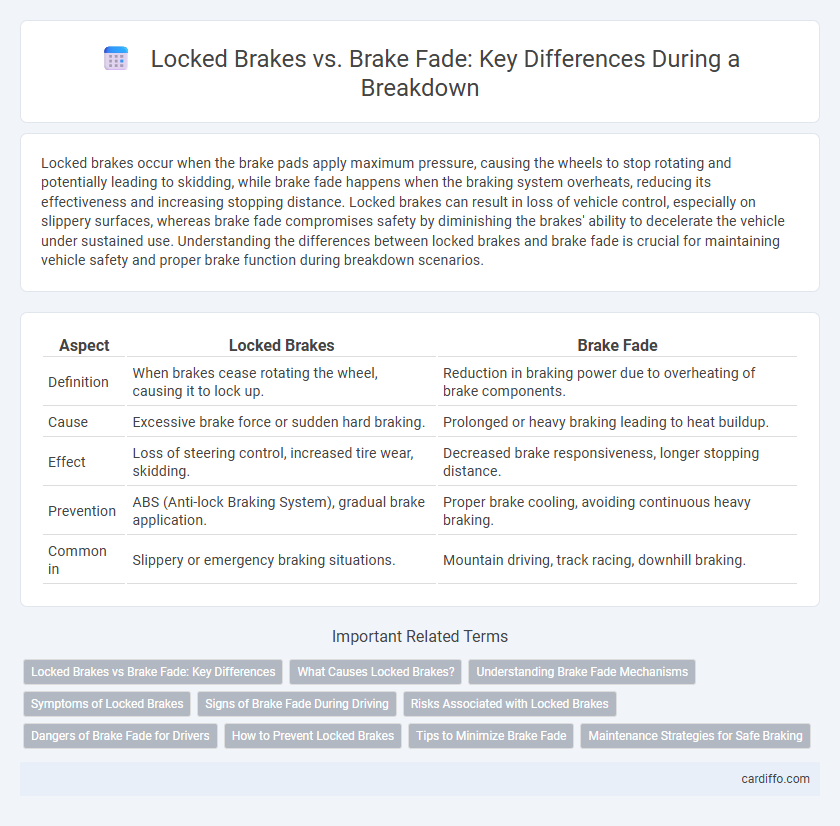Locked brakes occur when the brake pads apply maximum pressure, causing the wheels to stop rotating and potentially leading to skidding, while brake fade happens when the braking system overheats, reducing its effectiveness and increasing stopping distance. Locked brakes can result in loss of vehicle control, especially on slippery surfaces, whereas brake fade compromises safety by diminishing the brakes' ability to decelerate the vehicle under sustained use. Understanding the differences between locked brakes and brake fade is crucial for maintaining vehicle safety and proper brake function during breakdown scenarios.
Table of Comparison
| Aspect | Locked Brakes | Brake Fade |
|---|---|---|
| Definition | When brakes cease rotating the wheel, causing it to lock up. | Reduction in braking power due to overheating of brake components. |
| Cause | Excessive brake force or sudden hard braking. | Prolonged or heavy braking leading to heat buildup. |
| Effect | Loss of steering control, increased tire wear, skidding. | Decreased brake responsiveness, longer stopping distance. |
| Prevention | ABS (Anti-lock Braking System), gradual brake application. | Proper brake cooling, avoiding continuous heavy braking. |
| Common in | Slippery or emergency braking situations. | Mountain driving, track racing, downhill braking. |
Locked Brakes vs Brake Fade: Key Differences
Locked brakes occur when the brake pads apply constant pressure, causing the wheels to stop rotating and potentially skid, while brake fade is the gradual loss of braking power due to overheating. Locked brakes often result from sudden, excessive force on the brake pedal, leading to loss of vehicle control, whereas brake fade develops during prolonged braking, reducing braking efficiency. Understanding these differences is crucial for safe driving and effective brake system maintenance.
What Causes Locked Brakes?
Locked brakes occur when the brake pads apply excessive pressure to the rotors, preventing wheel rotation and causing the vehicle to skid. This condition is often triggered by hydraulic system failure, malfunctioning anti-lock braking systems (ABS), or improper brake fluid levels. Mechanical issues such as seized calipers or faulty brake lines can also lead to locked brakes, posing significant safety risks during driving.
Understanding Brake Fade Mechanisms
Brake fade occurs when repeated braking causes the brake components to overheat, reducing friction between the pads and rotors and leading to a gradual loss of stopping power. Locked brakes happen when the brake pads clamp too forcefully or for too long, causing the wheels to stop rotating and skid, which can compromise control. Understanding the thermal and mechanical factors behind brake fade is crucial for improving brake system design and ensuring vehicle safety under prolonged braking conditions.
Symptoms of Locked Brakes
Symptoms of locked brakes include a sudden inability to move the vehicle despite pressing the accelerator and a noticeable screeching or grinding noise from the wheels. Drivers may experience a strong jerking sensation or a complete halt in wheel rotation, often accompanied by smoke or a burning smell from excessive friction. These signs differ from brake fade, which features reduced braking power rather than immobilization.
Signs of Brake Fade During Driving
Brake fade during driving is characterized by a spongy or unresponsive brake pedal, requiring increased force to slow the vehicle. Drivers may notice a burning smell or hear unusual noises such as squealing or grinding when the brakes are applied. Reduced stopping power and longer stopping distances are key signs indicating brake fade, necessitating immediate inspection to prevent breakdowns.
Risks Associated with Locked Brakes
Locked brakes significantly increase the risk of losing control over the vehicle, leading to skidding and potential accidents. Unlike brake fade, which results from overheating and reduced braking efficiency, locked brakes cause wheels to stop rotating, reducing steering ability and increasing the chances of tire blowouts. This loss of traction is particularly dangerous on wet or slippery surfaces, making locked brakes a critical safety hazard during emergency braking situations.
Dangers of Brake Fade for Drivers
Brake fade significantly reduces stopping power during extended or intense braking, increasing the risk of accidents due to delayed vehicle response. Unlike locked brakes, which cause immediate wheel lockup and loss of control, brake fade gradually impairs brake performance, making it harder for drivers to judge stopping distances accurately. Understanding the dangers of brake fade is crucial for maintaining vehicle safety, especially on steep descents or long drives where sustained braking is common.
How to Prevent Locked Brakes
To prevent locked brakes, regularly check and maintain your anti-lock braking system (ABS) to ensure it functions correctly during emergency stops. Avoid sudden, hard braking by gradually applying pressure to the brake pedal, especially on slippery surfaces, to maintain traction and control. Keep tires properly inflated and replace worn brake pads to reduce the risk of wheel lockup and enhance overall braking performance.
Tips to Minimize Brake Fade
Brake fade occurs when excessive heat reduces braking efficiency, unlike locked brakes which result from full brake application causing wheel lockup. To minimize brake fade, regularly inspect and maintain brake fluid levels, use high-quality brake pads designed for heat resistance, and avoid prolonged downhill braking by shifting to a lower gear. Proper ventilation and allowing brakes to cool between heavy uses also help maintain optimal braking performance.
Maintenance Strategies for Safe Braking
Regular inspection and timely replacement of brake pads prevent locked brakes by ensuring proper friction and avoiding overheating. Brake fluid checks and bleeding maintain hydraulic pressure, reducing the risk of brake fade caused by air bubbles or fluid contamination. Implementing routine maintenance schedules and using quality brake components enhance overall braking performance and safety.
Locked brakes vs brake fade Infographic

 cardiffo.com
cardiffo.com